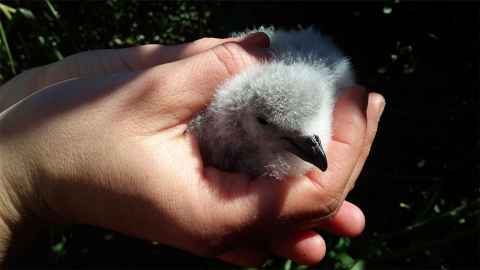Exploring why seabirds become bycatch
11 May 2021
Seabirds with a larger wingspan and bills or which have larger eyes and nostrils are more likely to end up as bycatch, a new study has found.

New Zealand is one of the world’s most important regions for seabirds, with a quarter of seabird species found here. Auckland alone is home to 27 species, making it one of the most important seabird breeding regions in the world.
But seabirds are one of the most at-risk groups of animals. Their greatest threat is as fisheries bycatch. Each year thousands are caught in fishing gear in New Zealand waters and recent research indicates that fishing vessels can function as sensory traps for the birds.
Sensory traps are situations that mimic situations that would normally be beneficial to a species but are instead dangerous because they are created by humans. So birds can be attracted by the smell of fish but if the fish is bait on a longline fishing vessel, the birds may die.
Having evolved with unique sound sensitivity and with a strong sense of smell and excellent vision, seabirds use these senses to navigate vast areas of the ocean and to raise their chicks in busy, noisy and smelly colonies. But these same acute senses may be the reason they are caught as a result of fishing.
University of Auckland PhD candidate Ariel-Micaiah Heswall and Dr Anne Gaskett from the School of Biological Sciences used fisheries bycatch data and analysed the skeletons and skulls of six seabird species to investigate what characteristics makes them most vulnerable to fishing.
They found that birds with larger bodies, such as the sooty shearwater, bills and wingspans were at greater risk of becoming bycatch because size meant they have a greater chance of becoming entangled in fishing gear.
But they also looked at sensory data and whether seabirds with relatively larger eyes and nostrils, such as the black petrel and flesh-footed shearwater, were irresistibly drawn to the smells, sight and sound of fishing vessels in action.
This means vessels and fishing generally, act as ‘sensory traps’ for some seabird species, drawn by attractive smells, lights and fishing gear and baits.
“The results of our study suggest that having a larger overall body size, longer protruding body parts and having relatively more sensitive sensory systems in terms of smell and sight means a higher risk of becoming bycatch,” Ms Heswall says.
“Looking at fishing activity – baits, discarded fish parts such as offal and smell – it can be seen as attractive to a range of seabird species but it also provides clues as to how it could be mitigated.
“Things like dyeing bait blue or using streamers on fishing vessels may help mitigate the risk but more research on which species are most vulnerable and why could be a useful next step.”
The research team also included Dr Amy Brunton Martin from Manaaki Whenua and Dr Megan Friesen from Saint Martin’s University in the United States. The study is published in Marine Biology.
Media contact
Anne Beston | Media adviser
DDI 09 923 3258
Mob 021 970 089
Email a.beston@auckland.ac.nz